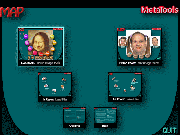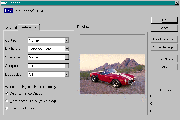
 Metatools, the company I love to hate,
has brought out another piece of software that would be amazing if it didn't
have an aggressively hostile user interface.
Metatools, the company I love to hate,
has brought out another piece of software that would be amazing if it didn't
have an aggressively hostile user interface.
Metatools has long been famous for its "Kai's Power Tools" series of image-editing plug-ins. Though of little interest to the average desktop publisher, Power Tools can be invaluable for high-end imaging and digital photography.
Unfortunately, Metatools has also long been famous for its user interfaces, which are either extremely innovative or totally insane depending on your personal taste. The company is completely unable to use simple labeled sliders and buttons like everybody else. Metatools products have to use weird rotating spheres, indescribable things you drag in peculiar ways, volcanoes instead of buttons, and so on.
There seems to be a certain type of software company that gets praised for an "innovative user interface" in an early version of their product. They then spend the rest of their time trying to top that original interface, with the result that far more effort goes into making the interface than the actual product. Metatools, which is the archetype of this kind of company, has apparently established a rule that no controls on a Metatools product can look like controls used by any other product.
 Needless to say, that makes the Metatools products look unusual, but it has some
rather revolting side effects. First of all, it prevents you from leveraging
knowledge you've gained using other products. Metatools is fundamentally opposed
to the idea behind GUI, where all controls and commands are visible, clearly
labeled, logical, and consistent across applications wherever possible.
Needless to say, that makes the Metatools products look unusual, but it has some
rather revolting side effects. First of all, it prevents you from leveraging
knowledge you've gained using other products. Metatools is fundamentally opposed
to the idea behind GUI, where all controls and commands are visible, clearly
labeled, logical, and consistent across applications wherever possible.
Second, it soon becomes impossible to remember what the controls do. Was I supposed to drag the snakey thing or double-click the volcano? Since the controls don't look like anything and often have no labels, the only way to find out is to try. Since many of Kai's products are only used occasionally, that means substantial re-learning every time you want to use the app.
Third, all this UI innovation means that user convenience becomes secondary. For example, the most recent version of Power Tools has a number of components built with fixed-size dialog boxes. Ignoring the fact that most of the imaging professionals who use Power Tools also use large, high-resolution displays, Metatools made these dialog boxes too small to see.
When this was brought to their attention, their only response was to suggest running at a lower resolution or using a "screen magnifier" program. Hardly the attitude of a company that cares whether customers can actually use their products.
This attitude has reached the point where I can no longer recommend Kai's Power Tools; the current version is just plain more trouble than it's worth.
This tirade is leading up to a mention of Kai's Power Goo, a peculiar and seductive program that manages to do lots of interesting, even stunning, things, all the while being really incredibly hard to use.
 Roughly, the idea behind Goo is to provide a reasonably-priced set of morphing
and image distortion tools that anybody can use. Indeed, Goo can do some
incredible things, performing manipulations in one step that might take dozens
of steps in an image editor like Photoshop. Goo can blend, morph, distort, and
combine images in hundreds of intriguing ways.
Roughly, the idea behind Goo is to provide a reasonably-priced set of morphing
and image distortion tools that anybody can use. Indeed, Goo can do some
incredible things, performing manipulations in one step that might take dozens
of steps in an image editor like Photoshop. Goo can blend, morph, distort, and
combine images in hundreds of intriguing ways.
Even better, Goo uses layering and alteration-caching techniques to preserve the quality of the underlying images, which prevents annoying "jaggies" regardless of the amount of manipulation. It can even produce simple movies from your transformations.
My description here is very inadequate; to really get an idea of what Goo is, you should visit the Goo web site. Even that doesn't do a good job. To really understand Goo, you have to try it.
That brings me to my major complaint about Goo. It's very hard to learn Goo if you've used other computer applications. The interface has a certain amount of internal logic, but why it was necessary to be so different from everyone else is beyond me. After using Goo for a while, I would have paid good money for a simple "File / Save" command or an ordinary slider control.
For example, most of Goo's controls have very similar names, like Smudge, Nudge, and Fudge. Figuring out which control does what is a problem. Further, as with all recent Metatools products, Goo's main window is fixed in size (640 by 480). To get a full-screen display, you have to run at 800 by 600 or below, which is a real nuisance for those of us that typically operate at much higher resolutions.
Goo's developers didn't forget to omit the little conveniences either: it's very easy to exit Goo without saving your work. In fact, you have to figure out to go to the "Out Room" to write your Goo to a disk file.
Metatools was also too lazy to create online help for Goo. The only assistance available is a one-page poster or a small, patronizing dialog box that suggests you connect to Metatools's Web site for more information. Since that site tends to be down a lot, you'd better hope you can figure out all the nuances of Goo on your own!
The biggest problem with the Goo interface is that it makes using Goo repeatably almost impossible. The controls have no graduations and work in strange ways. If you want to do the same thing to two different photos, you basically have to start over each time. Perhaps it's some native flaw in me, but I was unable to "Goo" the same thing the same way twice. In other words, Goo is at heart an incredible and innovative product, but its user interface makes it a children's toy.
 But what a toy! If you have children, Goo can provide them with countless hours
of creative entertainment. It's been my experience that young people below a
certain age derive infinite satisfaction from defacing and distorting the faces
of their peers, teachers, pets, and parents.
But what a toy! If you have children, Goo can provide them with countless hours
of creative entertainment. It's been my experience that young people below a
certain age derive infinite satisfaction from defacing and distorting the faces
of their peers, teachers, pets, and parents.
Goo can exert an intensely hypnotic influence on the more artistic sort of youngster. The effect is most pronounced if you have access to a digital camera or a scanner, so that the young artist can torture familiar faces, even though a set of generic faces is supplied on the Goo CD-ROM. A color printer can come in handy for generating refrigerator art.
Taken on its own terms, Goo is a very worthwhile toy for the artistic and almost useless as an imaging tool. It's well worth a look.
One Goo non-sequitur: even though I am not normally very sensitive to things like this, I noticed that all the faces on the Goo box are generic middle-class-looking white people. There are ethnic faces on the supplied CD-ROM, but none whatsoever on the box. I'm not at all sure what this says, but I think it says something.
 If you work with digital images, you may want to take a look at Extensis
Corp.'s Intellihance. Intellihance
is a plug-in for Adobe Photoshop and similar tools.
If you work with digital images, you may want to take a look at Extensis
Corp.'s Intellihance. Intellihance
is a plug-in for Adobe Photoshop and similar tools.
Intellihance combines several common image-enhancing filters into a single intelligent package. It greatly simplifies preparing and cleaning up digital images.
In the simplest case, you can just click the "Intellihance" button on the filter dialog box. The program will automatically examine your image and apply a set of filters to improve its appearance. Intellihance is remarkably skilled at making filter selections; after applying the intelligent enhancement, only a small amount of tweaking is usually needed to make a first-class image.
 If you want more control, Intellihance offers two levels of interactive
refinement. The "Preferences" level allows you to set a few general
parameters (e.g., contrast and sharpness) and see how the image changes.
Altering one high level setting may actually cause several sensing and filtering
operations behind the scenes.
If you want more control, Intellihance offers two levels of interactive
refinement. The "Preferences" level allows you to set a few general
parameters (e.g., contrast and sharpness) and see how the image changes.
Altering one high level setting may actually cause several sensing and filtering
operations behind the scenes.
There's also a "fine-tuning" level for low-level control of the enhancement operation, but I've rarely found that necessary. I spend most of my time using the "Preferences" dialog box.
 If
you're like me, you have way too many CD-ROMs. At one point, my desk was
littered with jewel boxes and CD caddies. It was a real problem.
If
you're like me, you have way too many CD-ROMs. At one point, my desk was
littered with jewel boxes and CD caddies. It was a real problem.
Most of my favorite games require a CD to be loaded when they're running. So do many development tools, such as Microsoft Visual C++. After a while, finding, cleaning, caddying, and loading CDs can seem to take up most of the day. There are always either too many CD caddies or too few.
The NEC MultiSpin 4Xc offers sweet relief from the drudgery. It's a CD-ROM changer that lets you access any one of seven CD-ROMs at will.
The 4Xc connects via a SCSI adapter. Once it's installed, your system will report seven new drive letters. You load CDs by pressing one of the seven buttons on the drive's front panel; pressing another button will close the drive's door.
Once the CDs are in place, you can access them by referring to the relevant drive letter. For example, if slot 1 maps to drive letter M:, slot 2 would be N:, and so on. If you refer to the drive letter of a CD that's not currently loaded, the changer will automatically switch to the correct disc.
I put my most commonly used CD-ROMs in slots 2 through 7, and I keep slot 1 empty for loading new software or using once-in-a-while discs. I often go for weeks without handling a CD-ROM disc.
The MultiSpin 4Xc is a device that solves a problem simply and reliably, without flash or fuss. For a street price of about $325, it provides quad-speed access to seven of your CD-ROMs. That's it.
There are only a few caveats
For more information, visit the NEC home page, or check out the MultiSpin 4Xc page.
![]()